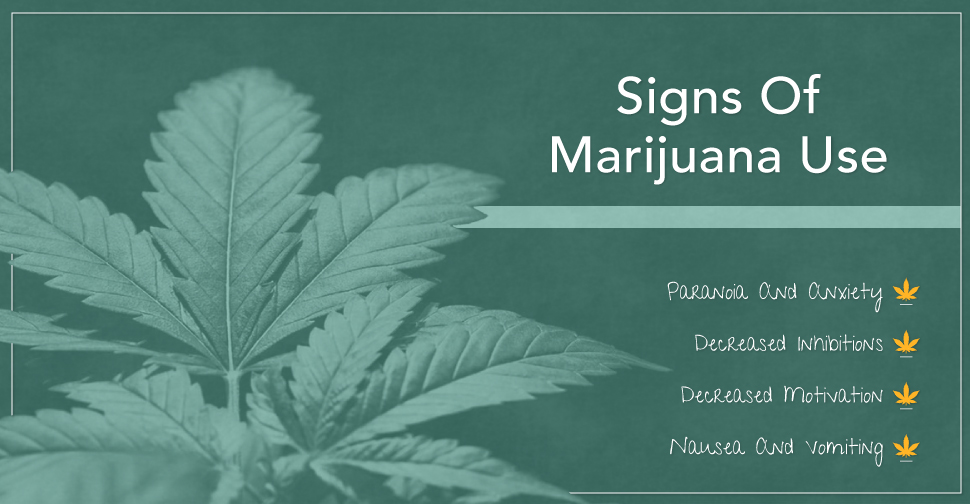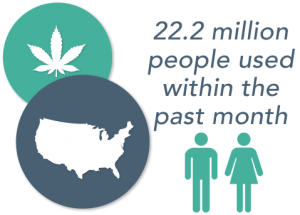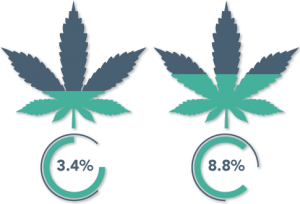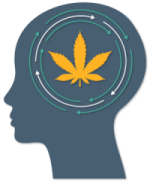
Marijuana is a drug that is used largely within social spheres, quite often within younger populations, though its recreational use does extend to individuals using it on their own as well. The National Institute on Drug Abuse reports that it is used more than any other illicit drug within the United States, citing findings from the 2014 National Survey on Drug Use and Health (NSDUH), that report that use within the past month was at an astounding 22.2 million people.

Within these staggering numbers is another daunting fact: many people may wrongly think that marijuana is a fairly innocuous drug. In fact, despite this age bracket’s steady use of the drug, NIDA reports young people are increasingly starting to believe that the drug is without risks. This is untrue. Despite the fact that some people may use marijuana for medicinal purposes, its illicit use imparts a variety of concerns within a user’s life.
The Components Of Marijuana Use
Some individuals feel that the lessening social stigma due in part to decriminalization efforts and the medicinal use is encouraging illicit use and this decreased perception of its risks.
When people use marijuana recreationally, or in pursuit of the “high” or euphoric effects, they are seeking the effects of the drug’s main chemical component, delta-9-tetrahydrocannabinol (THC). A partnership between the University of Mississippi and NIDA found that between 1993 and 2008, of 46, 211 samples, the percentage of THC had increased from 3.4 percent to 8.8 percent.

What people may not know is that our bodies contain naturally occurring endogenous cannabinoids, which are similar to those that are within marijuana, including THC. Due to this, the cannabinoids in marijuana have the ability to attach to the receptors in your brain that exist which are naturally occurring, resulting in what people call the “high.”
Marijuana impacts your brain in another way, by offsetting and changing the production of crucial neurotransmitters, specifically dopamine, a chemical that is key within your body’s reward and pleasure system.
Today, there exists a wide variety of ways that a person imbibes themselves with THC, beyond simply smoking marijuana. Some people may choose to use a vaporizer, in hopes of avoiding the chemical burden imparted by the smoke, and others, in increasing popularity over the past several years, may consume edibles (candy, baked goods, and even tea) or use various extracts, each delivery contains a measure of risk.
What Are The Signs And Symptoms Of Marijuana Use?
 Any time a person uses a drug, there will be some change within their physiology, and in addition, we often see side effects overtly present in their physical, mental, and emotional states. Marijuana is no different. Despite the fact that some people may think this is a harmless drug, it is not. In order to fully understand this and offer a person the help they need, we must be aware of the side effects and symptoms of this drug use, as well as the risks that they impart.
Any time a person uses a drug, there will be some change within their physiology, and in addition, we often see side effects overtly present in their physical, mental, and emotional states. Marijuana is no different. Despite the fact that some people may think this is a harmless drug, it is not. In order to fully understand this and offer a person the help they need, we must be aware of the side effects and symptoms of this drug use, as well as the risks that they impart.
Here we outline the behaviors that you can look for that point to marijuana abuse:
- Euphoria
- Increased state of relaxation
- Increased appetite
- Impaired sense of time
- Impaired cognitive abilities, including trouble thinking, learning, or solving problems
- Difficulties with memory
- Impaired motor skills, body movements, or coordination
- An altered mood
- Changes in the senses: people may experience things more acutely—colors might be more vivid or sounds more dynamic
- Some people may experience negative effects, including fear, paranoia, anxiety, or panic.
If you witness any of these in a loved one, please don’t convince yourself that it is a harmless activity, taking the steps to be proactive can protect your loved one’s body and mind, as the earliest intervention is the one that helps to prevent further health problems and lessen the chance of an addiction developing.
Marijuana Is Not Just Fun And Games
 Like many drugs, marijuana has both short- and long-term effects, some of which we are just beginning to understand. Research is quickening on the subject, and the detriment of this drug is becoming more evident.
Like many drugs, marijuana has both short- and long-term effects, some of which we are just beginning to understand. Research is quickening on the subject, and the detriment of this drug is becoming more evident.
In addition to what we’ve noted above, in the short term marijuana can:
- Cause nausea and vomiting, especially in the case of edibles if too much is consumed
- Decrease motivation and focus, which can lead to long-term effects
- Cause temporary changes to a person’s perception or mental state, including paranoia and anxiety
- Cause decreased inhibitions, which may make a person more apt to experience unsafe sexual practices, which may lead to long-term effects like an unwanted pregnancy or an STD.
The long-term repercussions may startle some people. They include:
- Suggestion that marijuana may precipitate other drug use
- Financial troubles in supporting the habit and incurring any legal fees from criminal use
- Impairs a person’s ability to safely operate a motorized vehicle which can result in damage or death
- Troubles sleeping
- Relationship troubles
- Decreased general states of physical and mental health
- Health decline with trouble breathing, lung irritation, illness, and infection
- Increased risk of heart trouble or complication
- Decreased sense of satisfaction with life, which may stem from the effects of decreased focus or ambition related to use
- In teens, marijuana is linked to decreased educational success, specifically lower grades, a decreased chance of going to college, and a reduction in graduation rates, both in high school and college.
- Can impair your performance on the job and overall employment status
- Research indicates it can exacerbate the symptoms of schizophrenia
- Use during pregnancy has been implicated in cognitive troubles for the child
The good news is that many of these side effects will resolve themselves when a person ceases using, however, some of the more severe may linger after use has ceased, which includes some measure of cognitive impairment.
Marijuana And Cognitive Impairment
A recent study, published in the journal Molecular Psychiatry this past March, delved into impairment and paid specific attention the the levels of dopamine that were produced with the striatum, a region of the brain that manages impulsivity, memory, and focus. It was found that “lower dopamine release in the associative striatum correlated with inattention and negative symptoms in CD, and with poorer working memory and probabilistic category learning performance in both CD and HC.” This serves to enforce the theory and growing body of research that suggests that using marijuana can cause cognitive deficits.
Short-term effects of marijuana use do manifest themselves as cognitive difficulties, however, many of these problems don’t fade when the high goes away. Cognitive difficulties, including those regarding memory, thinking, and learning may result from long-term use. Some research suggests that abuse and addiction can actually alter the workings of a person’s brain, this risk, we’re learning is especially prevalent during periods of adolescence, when a person’s brain is still developing.
Marijuana Is Addictive
When people think of marijuana, they may be quick to think about the drug’s euphoric effects that are glamorized on TV, film, and within day-to-day conversations. Despite the fact that this drug may bolster a person’s mood, there is an underlying truth that many people overlook—in fact, a truth that many people do not even realize. Marijuana can be addictive.
NIDA supports this, stating “Contrary to common belief, marijuana can be addictive. Research suggests that 30 percent of users may develop some degree of problem use, which can lead to dependence and in severe cases takes the form of addiction.” Due to this, drug use of this kind needs to be taken seriously, and may require treatment.
NIDA offers us more information on the subject, telling us that research suggests that of those who use marijuana, 9 percent will form a dependence, a number that rises to 17 percent when the use begins during a person’s teen years, because, as they also noted, those that use before they are 18, have a risk 4 to 7 times greater towards developing a marijuana use disorder than those that begin using as an adult.
Addiction happens because a person’s body adapts to the influx of chemicals that the marijuana contains, most notably the cannabinoids, and decreases its own production of those that are naturally occurring, hence, when a person suddenly ceases use, they may experience a sense of discomfort.
When a person who frequently uses stops using marijuana, they may actually experience symptoms of withdrawal, these included, as stated by NIDA “irritability, mood and sleep difficulties, decreased appetite, cravings, restlessness, and/or various forms of physical discomfort that peak within the first week after quitting and last up to 2 weeks.”
It is this discomfort that may often draw a person back to drug use, as they seek to avoid or alleviate these symptoms. This is one reason why therapy is so important, it can help you do avoid these drug-seeking behaviors by learning positive thoughts, skills, and behaviors to replace the damaging ones.
Treating Abuse And Addiction
A person may feel weak, ashamed, or silly for seeking help with their marijuana use. They shouldn’t. Reaching out for direction, support, and treatment for this and any drug is the wisest decision you can make. It helps to ensure your greatest chance at success, both within the realm of substance abuse and addiction, and beyond, in your life.
Currently there are no medicines that are used to treat marijuana addiction itself, however, behavioral treatments have been shown to be vastly successful in helping a person to overcome this, so that they may reclaim their life. These include cognitive behavioral therapy and contingency management, both of which help to develop and cement healthful behaviors. Motivational incentives may also prove useful, especially for teens, as they offer people a reward in exchange for their continued sobriety.
A good treatment program should address these co-occurring disorders and teach you how to positively control your thoughts and utilize your inner strength so that you can overcome any triggers and cravings and live a drug-free life. It will also teach you other ways to take care of yourself, instead of using drugs. In some cases, if a person has an underlying mental health disorder, their medical or addiction support team may recommend a medication that can address those concerns.
As we’ve noted before, withdrawal may accompany the cessation of use. Therapy can help you to alleviate some of these discomforts, and in some cases medications may be used to aid in the alleviation of symptoms.
Asking for help is a sign of strength and bravery, one that will reward you when you reap the benefits of treatment.
Don’t Let Your Life Go Up In Smoke
 Regardless of how you use it, marijuana isn’t just a good time. It is a drug that needs to be taken seriously, at DrugRehab.org our trained and supportive staff understands that. We can offer you information so that you may make the most informed decision about finding treatment, either for yourself or a loved one. Don’t hesitate, contact us today.
Regardless of how you use it, marijuana isn’t just a good time. It is a drug that needs to be taken seriously, at DrugRehab.org our trained and supportive staff understands that. We can offer you information so that you may make the most informed decision about finding treatment, either for yourself or a loved one. Don’t hesitate, contact us today.
Sources
National Institute on Drug Abuse – DrugFacts: Is Marijuana Medicine?
Proceedings of the National Academy of Sciences of the United States of America – Persistent cannabis users show neuropsychological decline from childhood to midlife
Live Science – Smoking Marijuana May Affect Weight Gain
National Institute on Drug Abuse – Drug Facts: Marijuana
National Institute on Drug Abuse – Marijuana Research Report Series

